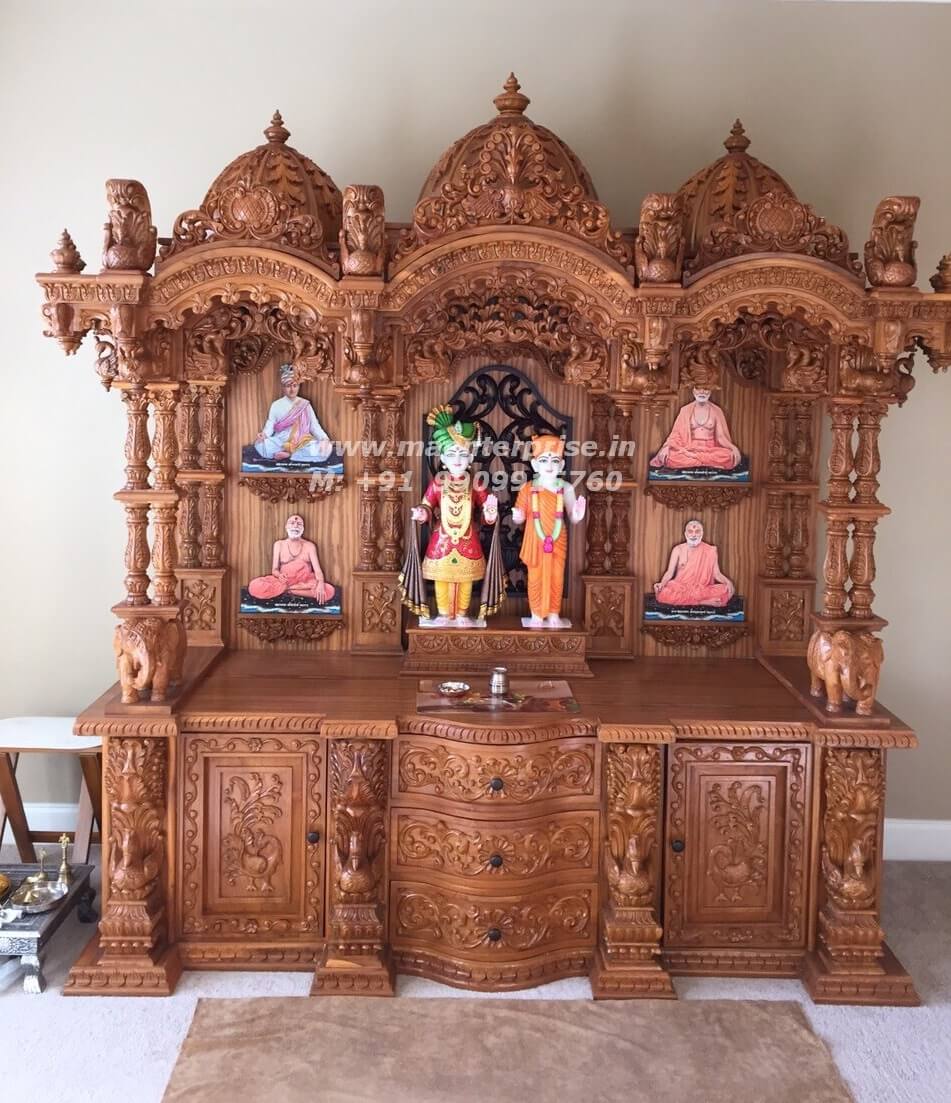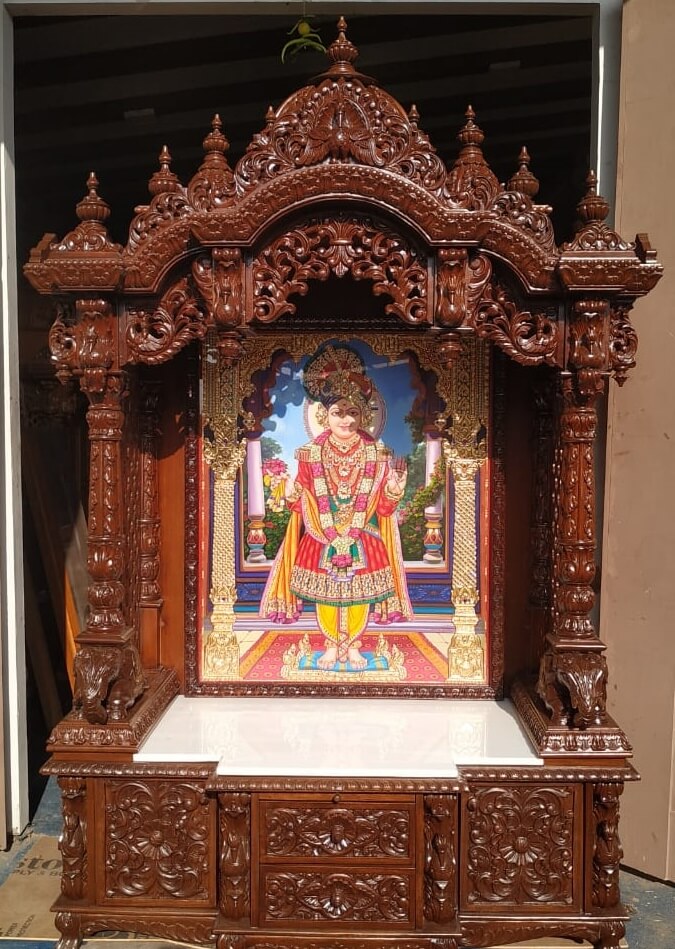
All the household have a pooja room at their house, where a Diya lit every evening and God is worshipped with pure faith. The pooja mandir and idol in our pooja room serve as a gateway to communicate with the supreme power. In India, there are many different religions and every religion has different sects, their own sets of rules, traditions, and beliefs.
One of the oldest and adhering to the doctrine of metaphysics as well as moksha is the Swaminarayan Sampradaya. Founded by Sahajanan Swami in 1801, who later came to be known as Swaminarayan; as he directed the devotees to chant the Swaminarayan mantra. The compound of two words - Swami and Naryan the five eternal entities viz. Parabhramha, Aksharbramha, Maya, Ishwar, and Jiva. His teachings concluded that the ultimate goal of life is Moksha i.e. liberation from the birth-death cycle.
Beliefs and Practices Thought by the Swaminarayan Sampradaya
All the teachings of Swaminarayan Sampradaya can be found in the Vachanmrut, the theological text. While articulating the Vachanamrut, Swaminarayan Vedanta philosophies, specifically the Vallabha, Chaitanya, Ramanuja, and Madhava. One can find the most similarities between Ramanuja’s Vishistadvaita and Swaminarayan philosophy.
Significance of Metaphysics in the Vachanmrut
The system of Swaminarayan Sampradaya revolves around five main entities, which are Parabhramha, Aksharbramha, Maya, Ishwar, and Jiva. Prapbrambha means God, who manifests on this planet to liberate those who seek the path of spirituality. Going by this concept, many Swaminarayan followers believe that he is the avatar of the Supreme power, including the Rama and Krisha.
The second entity, Aksharbhamha exists in four from viz. Parabramha’s adobe, the ideal devotee, who resides with him in the adobe, perceiving the feeling that Parabramha is omnipresent and supporting the universe, and fourth is the Aksharbhrama Guru, the one who guides the devotees throughout the spiritual path.
Maya is the eternal source consisting of three qualities serenity, passion, and darkness. This source is used by Parabrama to create the world.
Ishwar is the beings that are under the Parambharam They are ones who work under the instruction of the supreme power in creating, sustaining, and destroy the universe.
Jivas are the ones who reside in a body has a conscience. Jivas are mainly influenced by Maya and are trapped in the birth-death cycle. Their ultimate goal is to find Moksha.
Significance of Moksha and Practice of the Ekantic Dharma
Overcoming the influence of Maya is the ultimate way of attaining moksha. The way of overcoming Maya is by practising the Ekantic Dharma, which consists of devotion, fulfilling moral as well as religious duties, neutrality towards the worldly object, and realization of the Paramatma and atman. Contrary to this general idea, every Sanstha or Sampradaya of Swaminarayan has different beliefs on the way to attain moksha.
Various Traditions Associated with Swaminarayan Sampradaya
Praying in the Mandir
The Swaminarayan Sampradaya is well-known for its mandirs and architecture. Every mandir varies in ritual, architecture, and beliefs as per the Sanstha. Initially, six mandirs at Ahmedabad, Bhuj, Vadtal, Junagadh, Gadhada, were established for the devotees to worship. Now there are numerable mandirs, globally for devotional worship.
Bakti Tradition and Murti Poojan
Following the bhakti tradition, idola/murtis of God are housed through Pran Prathishta. It is believed that God resides in the murti after the ceremony and devotees can worship it. Thal, a ritual consisting of chanting, singing devotional songs, and offering food to the idol is practised three times a day.
Spiritual Tradition
Swaminarayan majorly encouraged the spiritual tradition by practising the teachings and gaining knowledge through Vachanamrut, Shikshapatri, Swamini Vato, Sacred biographies, Vedanta commentaries.
Major Sampradayas under Swami Narayan Sampradaya
As the Sampradaya started growing, Swaminarayan delegated responsibilities among the family members and followers (swamis). This gave birth to the different spiritual lineages and later turned into organisations/sampradayas, which are now spread across the world. The three major sampradayas are viz. Bochasanwasi Akshar Purushottam Swaminarayan Sanstha (BAPS), International Swaminarayan Satsang Organisation (ISSO) OR Kalupur Swaminarayan Sanstha, and Shree Swaminarayan Vadtal Dham.
Bochasanwasi Akshar Purushottam Swaminarayan Sanstha (BAPS)

Maharaj Shastriji formed this sampradaya in 1907, its principles revolve around the Vedas. BAPS leads their devotees to the lifestyles filled with spirituality and purity. Based on the Aksharbrahma-Parabrahma philosophy mentioned in the Vedas, they preach a comprehensive approach toward the ultimate liberation. Currently headed by Mahant Swami Maharaj, BAPS has more than 1100 mandirs.
The Devotees attached with this organization keep their Gurus Pics inside their Pooja Mandir along with Akshar Purushottam marble idol inside the mandir at the main central part, there are placed as Guruparampara inside mandir, these 5 gurus are Bhagatjimaharaj, Shastri Ji Maharaj, Yogi Ji Maharaj, Pramukh Swami Maharaj and Now Mahant Swami Maharaj. The pooja mandir for home for BAPS followers is of big size and has base drawers and cabiners
International Swaminarayan Satsang Organisation (ISSO) OR Kalupur Swaminarayan Sanstha:

Shree Tejendraprasadji Maharaj is the founder of ISSO and now they have temples across continents. Established in 1978, the major objective of ISSO to upgrade the Sanstha Dharma by aligning it with Swaminarayan Sampradaya.
The world’s oldest and first-ever Swaminarayan Mandir located in Kalupur, Ahmedabad, is run by ISSO. The sampradaya also runs a Gurukul in London, where teachings of Swaminarayan are preached in English. Recently in 2001, a charity program ISSO Seva was initiated under the Swaminarayan Sampraday.
The Devotees attached with this organization keep Only Photo frame of Sahajanand Swami inside their Pooja Mandir.
Shree Swaminarayan Vadtal Dham
Swaminarayan created a dual Acharyaship for his nephews a successor Acharya Maharajshree Ayodhyaprasad Pande and Acharya Maharajshree Raghuvir Pande. He carries out this acharya through a legal document known as Desh Vibhag no Lekh. There are two main branches of diocese viz Nar Narayan Dev Gadi headquartered at Ahmedabad and the Laxmi Narayan Dev Gadi headquartered at Vadtal.
This sampradaya believes in acharya tradition. The responsibilities include leading the followers towards Samanya Diksha by giving the guru-mantra, leading the monks towards Maha-Bhagwati Diksha, perform Pran Prathishtha, and fulfilling other duties as Guru of the Sampradaya.
Conclusion
The ideal kind of Pooja Mandir design can be the one that reminds you of the temple of the God you believe in. Staying in the close proximity of or God will always help us cut from the materialist word and lead us towards spirituality.
If you also wish to create a Pooja room same as one of the Swaminarayan Temples then you can go for the miniature replicas available at Darsh Home Decor (MA Enterprise). They deliver hand-crafted and customised wooden Pooja Mandir across the globe.



























